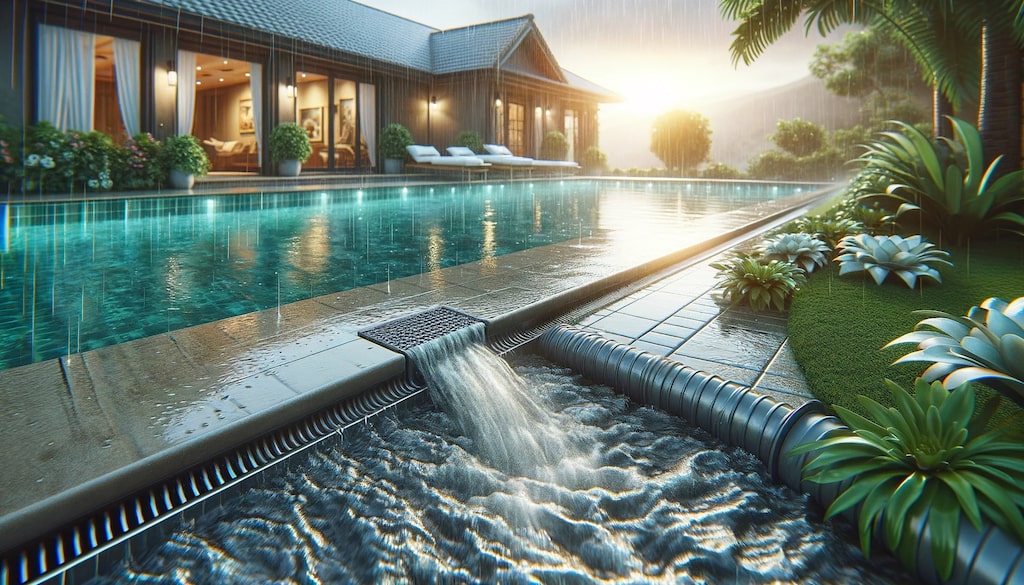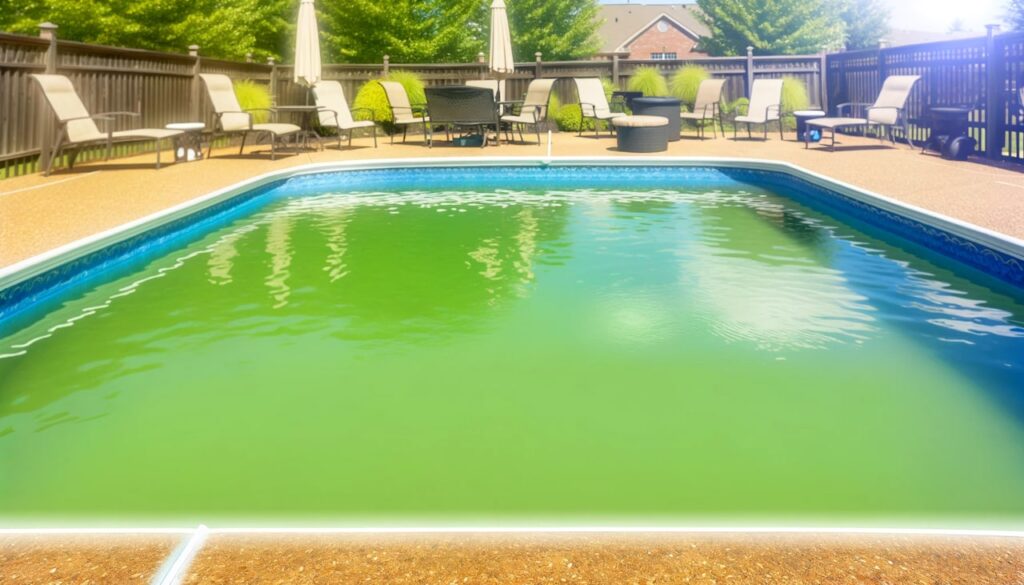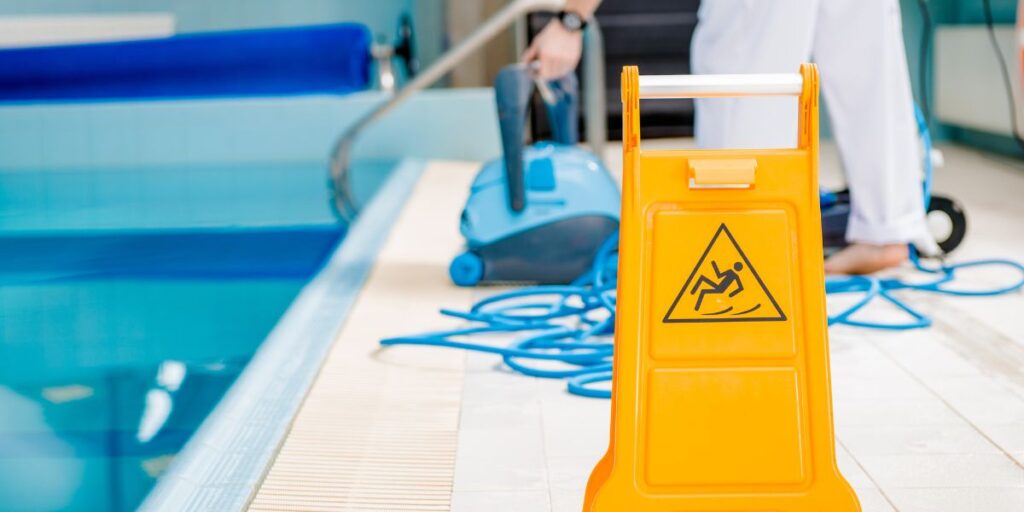Heavy rainfall can transform a calm backyard pool into a potential source of stress and property damage. While pools are designed to handle water, excessive amounts can lead to overflow, disturbing the delicate balance of pool maintenance. This article will guide you through immediate actions, damage assessment, and preventive measures to protect your pool and surrounding area from the consequences of overflow caused by rain.
Immediate Actions to Take When You Notice Overflow
Stop Additional Water from Entering the Pool
The first step is to ensure no additional water adds to the problem. If your pool is equipped with an automatic fill system designed to maintain water levels, turn it off. This prevents the system from counterintuitively adding more water during rainfall.
Removing Excess Water
To prevent water from spilling over and causing erosion or damage to nearby structures, it’s crucial to remove excess water. Here are methods to safely do so:
- Siphoning: You can use a garden hose to siphon water out of the pool. Place one end in the pool, and, using a pump or sucking the water until it starts flowing, place the other end at a lower elevation where you want the water to discharge. Ensure you’re complying with local regulations regarding where you can direct the water.
- Using a Submersible Pump: For faster removal, a submersible pump is more efficient. Place the pump in the shallow end of the pool and use a heavy-duty garden hose to lead the water to a suitable drainage area. Monitor the water level closely to avoid lowering it too much, which can cause structural damage or liner shrinkage in certain pool types.
- Adjusting Filter System Settings: If your pool has a multiport valve filter system, setting it to “waste” can bypass the filter and direct water straight out of the pool. This method is quick but can significantly reduce water levels, so it should be monitored continuously.
Assessing and Mitigating Damage
Once you’ve managed the immediate overflow, assess the pool and surrounding areas for potential damage.
Physical Damage: Check for signs of erosion around the pool area, especially if your pool is above ground or has landscaping nearby. Look for any damage to the pool liner, walls, or surrounding deck that may need repair. Addressing these issues quickly can prevent more extensive and expensive damage later.
Chemical Imbalance: Heavy rain can dilute your pool’s chemicals, making the water unsafe for swimming. Test the water’s pH, chlorine, and alkalinity levels using a pool water test kit. Adjust the chemicals as needed to bring them back to safe levels. It’s crucial to stabilize the pool chemistry to prevent algae growth and ensure the water is safe for use.
Debris Removal: Rain can wash all sorts of debris into your pool, from leaves and dirt to smaller particles that can clog your filtration system. Use a net to remove large debris and check your pool’s skimmer basket and pump basket. Backwash or clean the filter according to the manufacturer’s instructions to ensure it’s running efficiently.
Prevention Tips for Future Rainfall
Proactive measures can significantly reduce the risk of pool overflow and its associated troubles. Implementing a few strategic adjustments can save you time, money, and stress in the long run.
Install Drainage Systems: A well-designed drainage system around your pool can prevent overflow by directing excess water away from the pool and your home. Overflow drains or French drains are popular options. These systems involve installing a pipe around the pool’s perimeter, covered with gravel or a grate, which catches and redirects water. Consulting with a landscape architect or drainage specialist can ensure the system meets your property’s specific needs.
Use Pool Covers: A pool cover is a simple yet effective way to prevent rainwater from directly entering your pool. Automatic covers are convenient, providing easy deployment before a storm. Besides keeping out rainwater, covers also help maintain pool temperature and reduce evaporation, adding to their utility and cost-effectiveness.
Landscape Adjustments: Strategic landscaping can serve as a natural barrier to rainwater. Consider planting shrubs, and grasses, or creating berms in areas prone to heavy runoff. These can help absorb and redirect water away from your pool. Additionally, ensure your yard’s grading directs water away from the pool area to further mitigate overflow risk.
When to Call a Professional?
There are situations when DIY measures might not be enough to address or prevent pool overflow and its aftermath. Recognizing when to call in a professional can prevent further damage and ensure your pool’s longevity.
- Significant Damage: If you notice cracks in your pool’s structure, visible liner damage, or malfunctioning equipment after a heavy rain, it’s time to consult a professional. These issues can worsen over time and may require specialized knowledge to repair properly.
- Recurring Overflow: If your pool frequently overflows despite taking preventive measures, a professional can assess your property to identify underlying issues, such as inadequate drainage or landscaping problems, that DIY efforts might not resolve.
- Advanced Drainage Solutions: Installing comprehensive drainage solutions around your pool can be complex and requires an understanding of landscape architecture and hydrodynamics. Professionals can design and install systems tailored to your specific environment, ensuring effectiveness and compliance with local regulations.
Choosing a reputable pool maintenance service or landscape architect specializing in drainage solutions is crucial. Need expert help with your overflowing pool? As one of the best swimming pool builders in Austin and nearby areas, we are ready to provide customized pool repair and renovation services.
Conclusion
Dealing with a pool overflowing from rain can be a daunting task, but with the right knowledge and preparation, it’s a manageable situation. Taking immediate action to remove excess water and assess for any damage is crucial in the aftermath of heavy rainfall. Equally important is implementing long-term strategies to prevent future overflows, such as installing adequate drainage systems, using pool covers, and making smart landscaping choices. Recognizing when to call in professionals can also save you time and prevent costly repairs in the long run.
By following the guidance provided in this article, you can protect your pool and surrounding property from the potential damages caused by overflow, ensuring your pool remains a source of enjoyment regardless of the weather.



